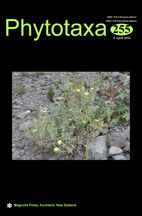Abstract
Grammothele and Theleporus have a shallow pore surface, which makes them morphologically close to corticioid fungi. However, from a phylogenetic perspective, they are polyphyletic genera within the core polyporoid clade of the Polyporales. Eight specimens with a shallow pore surface from Hainan, southern China, were morphologically and phylogenetically studied. Among them, one was determined as Grammothele denticulata, four were identified as Theleporus membranaceus, and three are described as Grammothele hainanensis. G. hainanensis is characterized by the annual and resupinate basidiocarps with poroid to irpicoid hymenophore, a dimitic hyphal system with clamped generative hyphae and weakly dextrinoid skeletal hyphae, the presence of cystidioles, hyphal pegs and dendrohyphidia, and cylindrical, hyaline and thin-walled basidiospores. It is closely related to G. quercina in phylogeny. Morphologically, G. quercina differs in producing perennial basidiocarps with cream to pale greyish and larger pores. The morphological differences among the new species and other species were analyzed.

